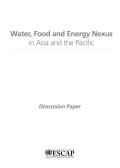
This study on innovative sanitation financing recognizes the challenge facing the region, to halve the proportion of the population without access to sanitation by 2015. The study proposes a “paradigm shift” to outcome models, recognizing that sanitation not only remains a focus of international development targets but is also linked to many other development issues such as health, environment, education, gender, disability, tourism and economic growth. This study proposes the inclusion of the private sector in a value proposition, with everyone in society benefiting from improved sanitation, and generating the willingness to pay for these services. ESCAP published this discussion paper, targeted for discussions at the Second Asia-Pacific Water Forum (2APWS), in Chiang Mai, May 2013, to provide background materials for the discussions at both the Technical workshops and the Focus Area Sessions.
More than 90% of impacts of climate change are related to water issues. These impacts are not only on water supply for household, industries and agriculture, but also on disasters and hazards during heavy rainfall, with flooded areas and landslides. During droughts, forest fires and haze have become the norm. The spread of poor quality water during floods and concentration of toxic water during drier months are an added health hazards. as such water security has become a truly global challenge.
Statistical Perspectives is a compilation of original graphs and charts covering the energy context and 7 areas of focus for realizing enhanced energy security as envisaged in the Asian and Pacific Energy Forum (APEF): energy access, energy efficiency, renewable energy, energy and environment, energy economics, energy trade and investment, energy connectivity. Various methods of data visualization are used to present statistics in a dynamic way, with no text, only the graphs and charts. While produced specifically to support negotiations in APEF, the subject matter addresses energy's role in multiple contexts, environmental, economic and social, across the member States of ESCAP in the Asia-Pacific region.
As cities are growing in terms of population and physical size, their contributions to national GDP are also increasing due to increased economic activities in urban areas. With this greater role of the urban sector, the demand for urban transportation – passenger and freight has increased many folds in the recent years. With the growth or urban economies, the living conditions and lifestyles of the city people are also changing. As income of the upper and middle class people in the city is increasing, the ownership of private vehicles is increasing rapidly. The Asian cities which do not have any growth management plan for controlling this rapid increase in personal vehicles are experiencing severe traffic congestion and other problems including air pollution, loss of personal and corporate productivity, high cost of transport and poor quality of life. Traffic congestion and air pollution have a negative impact on GDP as it imposes a significant cost in terms of both health and productivity. The traditional way of solving traffic congestion is to increase capacity of the road network.
